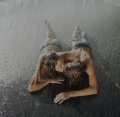***InG3RaSuL TaU PuFo
°Mega-VIP Immer Zusammen°๋
 Din: [:x] Am vIsAt sA zBoOoR [:X]
Inregistrat: acum 18 ani
Postari: 4449
|
|
Mid-1990s to late 1990s fashion
Gangsta style
Gangsta rap became one of the most prevalent styles of hip hop, and by the mid-1990s, hip hop fashion had taken on significant influence from the dress styles of street thugs and prison inmates. West Coast gangsta rappers adopted the style of Los Angeles' cholos (Chicano gangsters), including baggy pants, black ink tattoos, bandanas,and shirt tails outside one's pants. Dark denim prison gear were also popular.and locs.The style of sagging one's pants, or wearing them baggy and low without a belt, was also style that originated in prisons. This style of fashion, along with its associated hand signs and territorial or "homeboy" mentality, was adopted by African-American youth in Los Angeles initially, and later by the hip hop community at large. Hip hop artists such as Dr. Dre, Snoop Dogg, Ice Cube and Beastie Boys all wore and referenced Ben Davis workwear in videos and songs, a staple clothing brand amongst true gang/skate/hip hop/custom culture.
Fashion among hip-hop elites
On the West Coast, members of the hip hop community looked back to the gangsters of the 1930s and 1940s for inspiration.Mafioso influences, especially and primarily inspired by the 1983 remake version of Scarface, became popular in hip hop. Many rappers set aside gang-inspired clothing in favor of classic gangster fashions such as bowler hats, double-breasted suits,silk shirts, and alligator-skin shoes ("gators" . In some areas of the mid-west, including Detroit, this style has been a staple in hip-hop fashion, regardless of current trends . In some areas of the mid-west, including Detroit, this style has been a staple in hip-hop fashion, regardless of current trends
On the East Coast, "ghetto fabulous" fashion (a term coined by Sean Combs) was on the rise. Combs, the Notorious B.I.G., Faith Evans, Russell Simmons, and others were popularizing a style derived from high-fashion looks, but where luxury items were worn big and baggy
Tommy Hilfiger was the most prominent brand in 1990s sportswear, though Polo, Calvin Klein, Nautica, and DKNY were also popular.[7] When Snoop Doggy Dogg wore a Hilfiger sweatshirt during an appearance on Saturday Night Live, it sold out of New York City stores the next day.[7] Hilfiger's popularity was due to its perceived waspiness, which made it seem exclusive and aspirational.[7] Moreover, Hilfiger courted the new hip hop market: black models featured prominently in the company's advertising campaigns, and rappers like Puffy and Coolio walked during its runways shows.[7]
Other brands, including FUBU, Ecko Unlimited, Mecca USA, Lugz, Walker Wear, Boss Jeans by IG Design, and Enyce, arose to capitalize on the market for urban streetwear.[7] They followed in Hilfiger's footsteps by manufacturing all-American styles emblazoned with huge logos.[7]
The rise of hip-pop
The rise of hip-pop in the late-1990s, primarily the work of Sean "Diddy" Combs, known locally around New York at that time as the "Shiny Suit Man" brought elements such as loud, flashy PVC aviator inspired suits and platinum jewelry to the forefront of hip hop in an effort to add a new vivid dimension of color and flash to the videos produced as a marketing tool. Combs, who started his own Sean John clothing line, and clothing manufacturers such as Karl Kani and FUBU brought hip hop fashion to the mainstream, resulting in a multi-million dollar hip hop fashion industry. There was a resurgence of traditional African-American hairstyles such as cornrows and Afros, as well as the Caesar low-cut. Caesars and cornrows are maintained by wearing a do-rag over the head during periods of sleeping and home activity to prevent the hair from being displaced or tossled. Do-rags soon became popular hip hop fashion items in their own right.
The "hip-pop" era also saw the split between male and female hip hop fashion, which had previously been more or less similar. Women in hip hop had emulated the male tough-guy fashions such as baggy jeans, "Loc" sunglasses, tough looks and heavy workboots; many, such as Da Brat, accomplished this with little more than some lip gloss and a bit of make-up to make the industrial work pants and work boots feminine. The female performers who completely turned the tide such as Lil Kim and Foxy Brown popularized glamourous, high-fashion feminine hip hop styles, such as Kimora Lee Simmons fashion line of Baby Phat. While Lauryn Hill and Eve popularized more conservative styles that still maintained both a distinctly feminine and distinctly hip hop feel.
Bling culture
Main article: Bling bling
In the mid- to late 1990s, platinum replaced gold as the metal of choice in hip hop fashion.[3] Artists and fans alike wore platinum (or silver) jewelry, often embedded with diamonds. Jay-Z, Juvenile, and The Hot Boys were largely responsible for this trend.[3] Platinum fronts also became popular; Cash Money Records executive/rapper Brian "Baby" Williams infamously has an entire mouthful of permanent platinum teeth. Others have fashioned grills, removable metal jewelled teeth coverings.
With the advent of "bling" culture, the turn of the century established luxury brands made inroads into the hip hop market, with brands like Gucci and Prada making appearances in hip hop videos and films.[8] The most popular shoe of the era was the Nike Air Force 1, immortalized in the song by Nelly
34.1KB
_______________________________________

|
|
